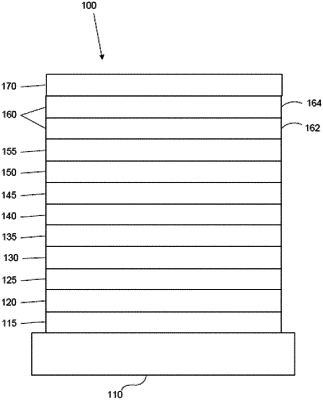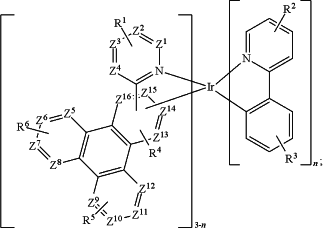| CPC C07F 15/0033 (2013.01) [H10K 50/11 (2023.02); H10K 85/342 (2023.02); H10K 85/40 (2023.02); H10K 85/622 (2023.02); H10K 85/654 (2023.02); H10K 85/655 (2023.02); H10K 85/6572 (2023.02); H10K 85/6576 (2023.02); H10K 50/12 (2023.02); H10K 50/81 (2023.02); H10K 50/82 (2023.02); H10K 2101/10 (2023.02)] | 17 Claims |

|
9. An organic light emitting device (OLED) comprising:
an anode;
a cathode; and
an organic layer, disposed between the anode and the cathode, comprising a compound of (LA)3-nIr(LB)n of Formula I
 wherein n=0, 1, or 2;
wherein Z1 to Z16 are each independently C or N;
wherein any of Z13 to Z16 is C when it forms a bond with Ir, or when it forms a bond with the ring having R1;
wherein any chelate ring comprising Ir is a 5-membered ring;
wherein R1 to R6 each independently represents mono to the maximum allowable substitution, or no substitution;
wherein each R1 to R6 is independently hydrogen or a substituent selected from the group consisting of deuterium, halogen, alkyl, cycloalkyl, heteroalkyl, heterocycloalkyl, arylalkyl, alkoxy, aryloxy, amino, alkenyl, cycloalkenyl, heteroalkenyl, alkynyl, aryl, heteroaryl, acyl, carboxylic acid, ether, ester, nitrile, isonitrile, sulfanyl, sulfinyl, sulfonyl, phosphino, and combinations thereof;
Z2 and Z3 are both C and each of Z2 and Z3 has a substituent R1 that is hydrogen, alkyl, or cycloalkyl group comprising five or more C atoms wherein the R1 that is alkyl or cycloalkyl may be fully or partially deuterated;
at least one R1 bonded to Z2 or Z3 is a cycloalkyl group comprising five or more C atoms;
the pyridine ring containing R2 has at least one substituent R2 that is an alkyl group;
the at least one R2 that is an alkyl group bonds at carbon 4 and/or 5 of the pyridine ring and the alkyl group is fully or partially deuterated;
at least one of the following is true:
R2 is an alkyl group that is partially deuterated;
the R1 that is cycloalkyl contains no deuterium or is Partially deuterated.
|